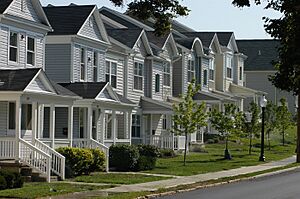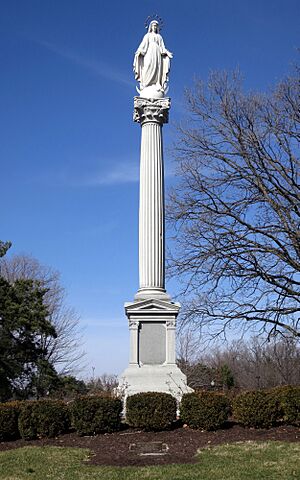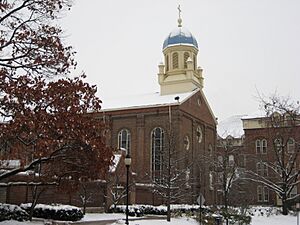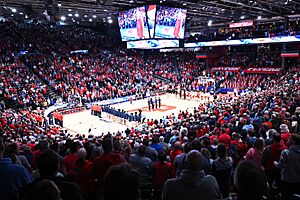University of Dayton facts for kids
 |
|
|
Former name
|
St. Mary's School for Boys St. Mary's Institute St. Mary's College (1878–1920) |
|---|---|
| Motto | Pro Deo et Patria (Latin) |
|
Motto in English
|
For God and Country |
| Type | Private research university |
| Established | 1850 |
|
Religious affiliation
|
Catholic (Marianist) |
|
Academic affiliations
|
ACCU NAICU Space-grant |
| Endowment | $862 million (2024) |
| President | Eric Spina |
| Provost | Darlene Weaver |
|
Academic staff
|
968 (fall 2023) |
| Students | 11,378 (fall 2023) |
| Undergraduates | 8,192 (fall 2023) |
| Postgraduates | 3,186 (fall 2023) |
| Location |
,
Ohio
,
United States
39°44′25″N 84°10′45″W / 39.740415°N 84.179213°W |
| Campus | Urban, 388 acres (1.5 km²) |
| Colors | Red and blue |
| Nickname | Flyers |
|
Sporting affiliations
|
NCAA Division I – A-10 Pioneer Football League MAAC (Women's golf) |
| Mascot | Rudy Flyer |
The University of Dayton (UD) is a private, Catholic university in Dayton, Ohio, United States. It was started in 1850 by a group called the Society of Mary. It is one of only three Marianist universities in the U.S. and the second-largest private university in Ohio. The campus is in southern Dayton and covers 388 acres, which is about 1.5 square kilometers. It's known for its beautiful Immaculate Conception Chapel and the University of Dayton Arena.
As of 2023, about 11,300 students attend the university. They come from many different backgrounds and places. The university offers more than 80 different study programs. These include subjects like arts, sciences, business, education, health, engineering, and law. In 2009, UD started one of the first college programs in human rights. It is also known for having "very high research activity."
Contents
History of the University of Dayton
How the University Started
In 1849, a man named Leo Meyer traveled from France to Ohio. He was on a mission to start a new place for the Society of Mary. When he arrived in Dayton, he met a farmer named John Stuart. John and his wife wanted to sell their farm because they had lost their baby daughter.
On March 19, 1850, Leo Meyer and three other Marianist brothers bought the 125-acre farm. They named it Nazareth. Just a few months later, on July 1, 1850, the University of Dayton began as St. Mary's School for Boys. It started with 14 students from Dayton. The school grew quickly. In 1855, the school building burned down, but classes started again very soon. By 1860, nearly 100 students were enrolled.
During this time, important buildings were constructed. These included Zehler Hall in 1865, the beautiful Immaculate Conception Chapel in 1869, and St. Mary's Hall in 1870. In 1882, the university was officially allowed to give out college degrees by the State of Ohio.
Important Moments in History
In 1913, a big flood hit Dayton. Many people needed help, and St. Mary's College was a safe place on a hill. The college had plenty of food and supplies because students were away for a break. It also had working electricity, heat, and clean water. The college helped feed local hospitals and gave shelter to 800 people.
In 1920, the school changed its name to the University of Dayton. This new name showed its strong connection to the city. In 1923, the university's sports teams became known as the "Dayton Flyers." The university also chose its motto: "Pro Deo et Patria", which means "For God and Country" in Latin. In the 1930s, women were allowed to attend the university just like men. This was much earlier than many other Catholic universities.
The growing Catholic community in Dayton faced challenges from a group called the Ku Klux Klan in the 1920s. On December 19, 1923, the university campus was targeted. However, hundreds of neighborhood residents and students came together to protect the campus and chase the group away.
In June 2014, the University of Dayton announced it would stop investing in companies that use coal and fossil fuels. It was one of the first Catholic universities in the country to do this.
How the Campus Grew
Starting in the 1960s, the university began buying houses near the campus for student living. This helped the campus grow. In 2005, the university bought 49 acres of land that used to be a factory. This made the campus much larger, reaching the Great Miami River.
In 2009, the university bought another 115 acres, including the former headquarters of a company called NCR. This made the campus 373 acres in total. The old NCR headquarters building is now used for research, classrooms, and offices. In 2010, GE Aviation built a large research lab on the campus.
By 2012, the campus covered about 388 acres. It had 38 buildings for classes, research, sports, and offices. It also had five dorms, 18 apartment complexes, and 473 houses for students.
The number of students grew a lot after World War II. By 1950, there were over 3,500 students. When many young people started going to college, the university's student count went over 10,000. By 2012, more than half of the students were from outside Ohio. Many international students also joined, with over 1,500 in 2012.
Marianist Traditions
The University of Dayton was founded by priests and brothers from the Society of Mary. It is one of three Marianist universities in the U.S. The university works to keep its Marianist identity and values strong. In 2005, a program was started to teach leaders about the Marianist educational ideas.
The university was led by Marianist priests and brothers until 2002. That's when Daniel J. Curran became the first president who was not a Marianist. Eric F. Spina became the 19th president in 2016.
University Presidents
- Leo Meyer (1850–1857)
- John B. Stintzi, S.M. (1857–1860)
- Maximin Zehler, S.M. (1860–1876)
- Francis E. Feith, S.M. (1876–1879)
- George Meyer, S.M. (1879–1887)
- John Harks, S.M. (1887–1889)
- Joseph Weckesser, S.M. (1889–1896)
- Charles Eichner, S.M. (1896–1902)
- Louis A. Tragesser, S.M. (1902–1908)
- Bernard P. O'Reilly, S.M. (1908–1918; 1923–1932)
- Joseph A. Tetzlaff, S.M. (1918–1923)
- Walter C. Tredtin, S.M. (1932–1938)
- John A. Elbert, S.M. (1938–1944)
- George J. Renneker, S.M. (1944–1953)
- Andrew L. Seebold, S.M. (1953–1959)
- Raymond A. Roesch, S.M. (1959–1979)
- Raymond Fitz, S.M. (1979–2002)
- Daniel J. Curran (2002–2016)
- Eric F. Spina (2016– )
University Campus
The University of Dayton campus is about 388 acres. It is divided into four main areas: Historic Campus, Campus West, River Campus, and Arena Sports Complex. The campus has many buildings for classes, research, sports, and offices. It also has five dorms, 18 student apartment buildings, and 473 houses, with 347 owned by the university.
Historic Campus Buildings
At the heart of the campus are St. Mary's Hall and the Immaculate Conception Chapel. The chapel's blue dome inspired the university's logo. St. Mary's Hall used to be a dorm and classroom. Today, it holds important offices like the president's office and student services.
St. Joseph Hall was built in 1884 as a dorm. After a fire in 1987, it was rebuilt and reopened in 1989. It now has classrooms and offices for social sciences. Chaminade Hall, built in 1904, is named after William Joseph Chaminade, who founded the Society of Mary.
Kettering Labs is where the School of Engineering is located. It has classrooms, labs, and a wind tunnel. The Jesse Philips Humanities Center, built in 1993, houses departments like English and history. It has classrooms, computer centers, and a recital hall.
Miriam Hall is home to the School of Business Administration. It has special classrooms and centers for business studies. The Science Center includes Sherman Hall, Wohlleben Hall, and a connecting area. It houses departments like math, biology, and chemistry.
Keller Hall, opened in 1997, is home to the University of Dayton School of Law. It has classrooms, offices, and courtrooms. The John F. Kennedy Memorial Student Union, or Kennedy Union, is a popular spot for students. It has dining, a coffee shop, a game room with bowling, and a theater.
The Central Mall is a large green space in the middle of campus. The Roesch Library is the main library. It also houses the Marian Library, which has the world's largest collection about Mary, the mother of Jesus.
The RecPlex opened in 2006. This large building has rooms for exercise, a climbing wall, courts for various sports, a swimming pool, and a track. The Frericks Center is a gym with 5,000 seats. It is now home to the women's volleyball team.
The Cronin Athletics Center is used by all 17 sports teams. It was recently updated with larger offices and practice spaces. Stuart Field was updated in 2011 with a special turf for sports.
Raymond L. Fitz Hall has many university departments and programs. These include art and design, music, physical therapy, and public safety. Jessie S. Hathcock Hall, completed in 2021, houses the computer science program. It is named after Jessie Scott Hathcock, the first African-American woman to graduate from the university.
Campus West Area
In 2005, the university bought more land and buildings next to the main campus. This added 49 acres and made the campus nearly 25 percent larger. Raymond L. Fitz Hall is the main building in this area. It holds many campus offices and academic departments.
The Graul Tennis Complex, finished in 2010, has six tennis courts. In 2011, GE Aviation started building a large research facility on Campus West. This center, called EPISCENTER, opened in 2014. University researchers work with GE here on electrical power systems.
River Campus Area
In 2009, the university added 115 acres to its campus. This included the former world headquarters of NCR Corp. The main building, Daniel J. Curran Place, is now home to the University of Dayton Research Institute. It also has classrooms and offices.
Arena Sports Complex
The University of Dayton Sports Complex is west of the Great Miami River. It includes the University of Dayton Arena, which seats 13,409 people. It also has fields for baseball and softball. Welcome Stadium, an 11,000-seat stadium, is used by local high schools and the Dayton Flyers football team.
Academics and Learning
The University of Dayton has five main academic areas:
- College of Arts and Sciences
- School of Business Administration
- School of Education and Health Sciences
- School of Engineering
- School of Law
The College of Arts and Sciences is the largest. It offers over 50 different programs. The university was one of the first to offer a college program in human rights in 1998. Special centers offer deep study and research. The Fitz Center focuses on helping communities. The Institute for Pastoral Initiatives helps with religious education online. The Center for Tissue Regeneration and Engineering does research on growing new tissues.
The School of Education and Health Sciences offers programs for teachers and health professionals. The Lalanne Program helps new Catholic school teachers by combining service and teaching.
The School of Engineering offers many degree programs. Students can do research in one of the school's 10 centers.
Flyer Enterprises runs several businesses on campus. It is one of the largest student-run businesses in the nation. Students manage nearly $60 million of the university's money in the Davis Center for Portfolio Management.
The University of Dayton School of Law is one of nine in Ohio. It offers a regular three-year law degree and a faster two-year option. It was one of the first schools to offer a two-year law program.
Becoming a Student
| Admissions statistics | |
|---|---|
|
2023 entering
class |
|
| Admit rate | 61.8% |
| Yield rate | 13.9% |
| Test scores middle 50%* | |
| SAT Total | 1180–1350 (among 12% of FTFs) |
| ACT Composite | 24–30 (among 37% of FTFs) |
| High school GPA | |
| Average | 3.75 |
|
|
Getting into the University of Dayton is considered "selective." In 2023, the university received over 22,000 applications. It accepted about 62% of applicants. About 14% of those accepted chose to enroll. The average high school GPA for new students was 3.75.
In 2013, the university started a new tuition plan. It guaranteed that a student's grants and scholarships would increase each year to cover any tuition rise. This plan also removed extra fees and offered free books.
University Rankings
| USNWR National University | 136 |
|---|---|
| Washington Monthly National University | 137 |
| Forbes | 169 |
In 2025, U.S. News & World Report ranked the University of Dayton's undergraduate program 136th among national universities.
Studying Abroad
The University of Dayton offers nearly 50 programs for students to study or volunteer abroad. Students can go for a summer, a semester, or a full year. Programs are available in many countries, including Argentina, China, France, Germany, Italy, and the United Kingdom.
The Center for Social Concern also offers volunteer trips during school breaks. These trips go to places like Cameroon, India, Ecuador, and Mexico.
Research at UD
The University of Dayton Research Institute (UDRI) has done over $2.5 billion in research since it started. Most of this research is in engineering. More than 370 students work with researchers.
The university's engineering research helped GE Aviation decide to build its new research center on the University of Dayton campus. This center opened in 2014.
The Research Institute has seven divisions, focusing on areas like aerospace, energy, and materials. There are also 10 research centers in the School of Engineering.
The University of Dayton has received over 150 patents. These include a patent for the special hotbags that Domino's Pizza uses to keep pizzas warm. Researchers at UDRI have also invented things like a "smart" dipstick to check oil quality and a self-healing wire. They also developed a system used at airports to stop runaway planes.
Student Housing
More than 90 percent of students live in housing on campus. All first-year students must live in a dorm. Older students can live in dorms, apartments, or university-owned houses.
Dorms for Students
Founders Hall is U-shaped and houses 400 first-year students. Marianist Hall, built in 2004, has three parts. It houses both first-year and second-year students. It also has a chapel, bookstore, and food court.
Marycrest Complex is the largest housing area, with 940 first-year students. It has double rooms and a dining facility. Stuart Complex has three separate halls for 632 first-year students. It also has a convenience store.
Virginia W. Kettering Hall (VWK) houses 636 second-year students in suites. Each suite has a living room, two bedrooms, and a bathroom. This dorm also has a dining room.
Apartments for Students
The university owns several apartment buildings for students. These include Lawnview Apartments, Campus South, Garden Apartments, and Plumwood Apartments for law and graduate students.
The Caldwell Street Apartments opened in 2012. This $25 million project houses over 400 older students in townhouse-style apartments. ArtStreet opened in 2004. It offers apartments for juniors and seniors and has studio facilities, a student-run café, and a radio station.
Student Neighborhoods

The University of Dayton has a large student neighborhood. It has over 400 houses owned by the university and private landlords. Students often call this area "the Ghetto." The university started buying properties here in the 1950s.
Student Life and Activities
The university has Integrated Learning Living Communities (ILLCs). These groups help students learn about a topic while living together. Topics include "Writing and the Arts" and "Women in Science and Engineering."
Campus Ministry
The Office of Campus Ministry helps with religious life on campus. It organizes church services, retreats, and faith groups. There are campus ministers in dorms and student neighborhoods. The university also has a minister for students from different Christian backgrounds.
The Mass schedule includes daily and weekly services. Campus ministry offers several retreats throughout the year. Student religious groups include Athletes in Action, Catholic Life, and the Muslim Student Association.
Service Learning
The University of Dayton offers many chances for students to volunteer and help others. The Fitz Center for Leadership in Community and the Center for Social Concern organize these opportunities. Students can volunteer in local neighborhoods or go on international trips during breaks.
Christmas on Campus
Every year since 1964, usually on December 8, University of Dayton students host about 1,000 local school children. They give them gifts and lead them through campus for games, dancing, singing, crafts, and a visit with Santa Claus. The event is free and open to everyone. It includes a live Nativity scene and a Christmas tree lighting. The evening ends with students attending a Mass.
Ellie Kurtz, who directed the student union, started Christmas on Campus. She wanted students to celebrate Christmas together before going home for winter break.
Sports and Clubs
Besides varsity athletics, there are 37 club sports and 12 intramural sports. In 2006, the university opened RecPlex, a large sports facility for students. The Princeton Review ranked the University of Dayton first for "Everybody Plays Intramural Sports."
The men's lacrosse club team won national championships in 2015 and 2023.
Student Media
The University of Dayton has a student newspaper (Flyer News), a student-run radio station (WUDR Flyer Radio), a student-run TV station (Flyer Station), and an art and literary magazine (Orpheus).
Greek Life
Fraternities and sororities have been part of student life since 1933. In 2015–16, about 15 percent of undergraduate men and 22 percent of undergraduate women were members of a fraternity or sorority.
Athletics and Sports
The Dayton Flyers compete in the Atlantic 10 Conference for most sports. For football, they play in the Pioneer Football League. The Flyers' mascot is "Rudy Flyer," a pilot who wears goggles and a leather helmet. The nickname "Flyers" honors the Wright Brothers, who invented the airplane in Dayton. The fight song is "Victory."
The university has 16 sports teams, including men's and women's basketball, soccer, and tennis. The Red Scare is the student spirit group that supports the teams. Dayton has rivalries with other Ohio schools like the Cincinnati Bearcats and Xavier Musketeers.
The Dayton Flyers men's basketball team is very popular. They often rank among the top college basketball teams for attendance. The men's basketball team reached the NCAA Championship final game in 1967. They also won the National Invitational Tournament in 1962, 1968, and 2010. In 2014, the men's basketball Flyers made it to the NCAA Elite Eight.
The football team won national titles in 1980 and 1989. The women's basketball team won a national championship in 1980. The women's volleyball team has been in the NCAA tournament 15 times. The women's soccer team has been in the NCAA tournament 10 times.
The University of Dayton Arena has hosted more NCAA Division I Men's Basketball Championship games than any other place in the U.S. Since 2001, the university has hosted the start of the NCAA men's basketball tournament.
Famous People from UD
See also
 In Spanish: Universidad de Dayton para niños
In Spanish: Universidad de Dayton para niños







